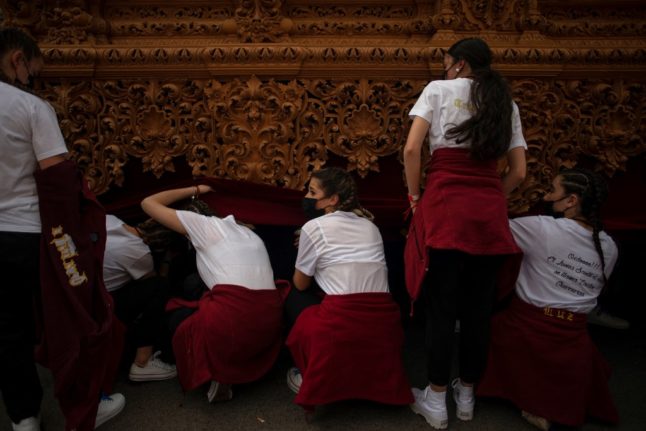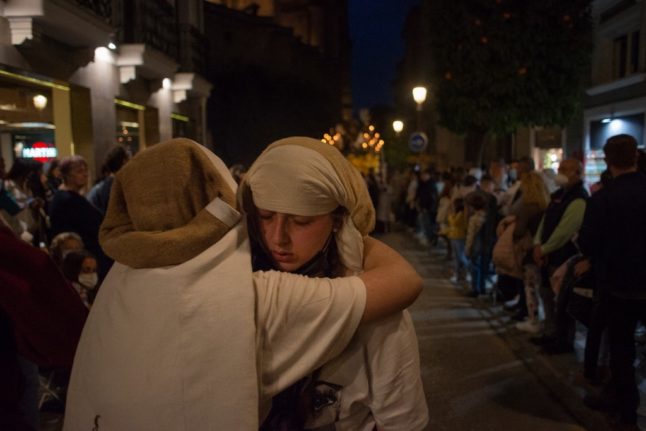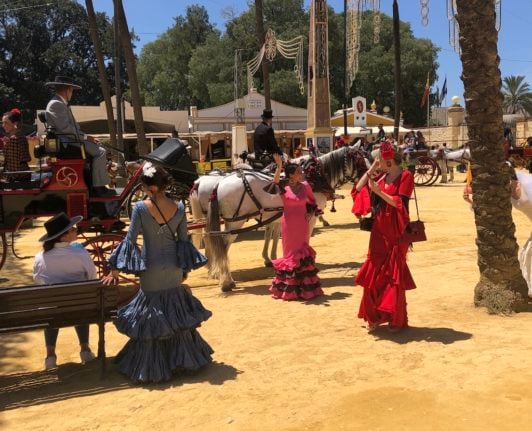On Holy Monday in the historic city of Granada in southern Spain, a team of 50 women rock rhythmically from foot to foot carrying a 1.5-tonne float topped with a statue of Jesus and Mary.
They support the weight on wooden ribs under the belly of the float as they inch forward through the city for ten hours.
A heavy velvet cloth draped over the float leaves only their white shoes visible to throngs of spectators lining the route.
The parades featuring dozens of people dressed in religious tunics and distinctive pointy hoods have returned this Holy Week after being cancelled due to the Covid-19 pandemic the past two years.
While religious orders started allowing women to carry floats in Spain’s famous Easter processions 30 years ago, female “costaleros” — as float bearers are known — remain a minority who still face resistance.
Women have traditionally formed the back line of the processions, playing the role of mourners dressed in stylish black dresses, embroidered veils and intricately designed hair combs.
Granada’s “Work and Light” brotherhood was among the first to allow women to carry the floats in the 1980s.

At first “it was not accepted, women were talked bad about,” said Pilar del Carpio, a 45-year-old cashier who has been a shrine bearer since she was 13 and is proud to be one of the “pioneers”.
Today only three or four of Granada’s 30 brotherhoods, which stage the processions, include women costaleras.
“Maybe there are people who think it is not normal,” said Maria Auxiliadora Canca, a 40-year driving instructor who directs a team of float bearers in Ronda, another Andalusia city in southern Spain.
“Since our bodies are capable of doing it, and we do it with conviction, I don’t see why there should be a difference.”
‘Scandal’
But in Seville, which holds Spain’s most spectacular Easter parades, there are no women float bearers even though the city’s archbishop in 2011 issued a decree to put an end to gender-based discrimination in the city’s religious orders.
Opponents claim the task is too physically demanding, “not suitable” for women.
“It’s a scandal,” said Maribel Tortosa, 23, who manages an Instagram account called “Costaleras por Sevilla” dedicated to women float bearers.
People say that it is “ugly” to see a woman wearing a “costal”, the traditional padded sack used by bearers as protective headgear, she said.

“But under a float, you don’t see anything,” she added.
Still, the emergence of women float bearers reflects the growing push by women in Spain into traditionally male-dominated fields since the return of democracy in the 1970s.
Spain’s oldest police force, the Guardia Civil, has since 2020 been headed by a woman — a first in its 178-year history.
And since Socialist Prime Minister Pedro Sánchez came to power in 2018, women have taken up most cabinet posts for the first time in history.
‘Strong enough’
In Granada, locals are no longer surprised to see women training on the streets in the lead up to Holy Week by lifting and carrying a float loaded with bricks.
The load “weighs more every hour”, even though the shrine bearers are replaced every half hour during the “Work and Light” brotherhood’s procession, which began Monday at four pm and ended at around one am, said Rafael Perez, who heads the team of women shrine bearers.
Working with women “changes absolutely nothing. I just have to treat them with more tenderness,” said Perez.
Among the women of this religious order was Montse Ríos, 47, who has been a bearer since she was 19 and who still feels “strong enough to go under”.
Her eldest daughter joined her this week under the float, while her youngest is a “pipera”, giving water to the procession participants.
“And we don’t lack that,” she added.







 Please whitelist us to continue reading.
Please whitelist us to continue reading.
Member comments